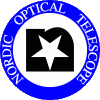







|
|
Photometry: ALFOSC
What do I do?
- Go to the folder ~obs/scripts/53-032
- Execute the script too-alfosc-photometry.sh
./too-alfosc-photometry.sh
Description:
First preset the telescope to the TCSTGT (TCS catalogue entry; OBJECT).
The user is requested to check guiding and press return to continue if OK. Then
NUM_EXP exposures with EXP_TIME exposure time are taken for each
filter FILTER. Optionally, a dither pattern DITH_PAT
with dither step DITH_STEP, CCD window xsize
XSIZE, ysize YSIZE and CCD amplifier
AMPLIFIER may be set.
The script exits with full CCD window, high gain, field rotation 90 and guiding off.
Format:
./too-alfosc-photometry.sh OBJECT FILTER,EXP_TIME,NUM_EXP ... [dither=DITHER xsize=XSIZE ysize=YSIZE ampl=AMPLIFIER]
OBJECT: Object name (as defined in the TCS catalogue entry)
FILTER: FILT_ID[:FILT_FOC]
FILT_ID: Filter ID (as defined here)
| FILT_ALIAS
FILT_ALIAS: U(7) | B(74) | V(75) | R(76) | I(12) | U_SDSS(109) | G_SDSS(120) | R_SDSS (110) | I_SDSS (111) | Z_SDSS(112)
FILT_FOC: Filter focus offset
EXP_TIME: Exposure time (in seconds)
NUM_EXP: Number of exposures
DITHER: DITH_PAT:DITH_STEP | no (default)
DITH_PAT: Dither pattern (2-point-x | 2-point-y | 3-point-x | 3-point-y | 4-point | 5-point | 9-point | abba-x | abba-y)
DITH_STEP: Dither step (in arc seconds)
XSIZE: CCD window x size (in pixels) | full (default)
YSIZE: CCD window y size (in pixels) | full (default)
AMPLIFIER: CCD amplifier (A | B | AB | C | AC)
Example:
./too-alfosc-photometry.sh GRB100316D U,60,3 B,60,3 V,60,3 R,60,3 I,60,3 Z_SDSS,60,3 dither=3-point-x:10
will take 3 exposures of 60 seconds each in each of the filters U(7), B(74), V(75),
R(76), I(12) and z' (112) of GRB100316D. Dithering with 3-point-x pattern and a 10 arcsec
step will be used. Observations are in full-frame mode. The atmospheric dispersion corrector (ADC) is
automatically taken out the beam.
Note: If the command is getting too long you can add a line break, e.g.
./too-alfosc-photometry.sh GRB100316D U,60,3 B,60,3 V,60,3 \
R,60,3 I,60,3 Z_SDSS,60,3 dither=3-point-x:10
Remark about the dither mode.
- What happens if the number of exposures exceeds the number of available positions
per dither cycle, i.e., 3 exposures with a 2-point dither pattern?
It is OK to do this but not optimum. The starting point of the following dither
cycle can be identical to first position of the previous one, e.g., for the
2-point and 3-point dither patterns, or identical to another position of a
previous cycle. This can be avoided by picking a dither pattern that provides
more positions than your number of exposures.
- Is the dither mode reset between any two command executions?
Yes. Re-pointing the telescope to a slightly different position before executing
the second command might be sensible to do.
-
Send an email to the FRB team and add in the End-Of-Night report,
which images were made, and approximately how much time you spent in total.
-
If you have any problems or questions contact your support on duty. You are also welcome
to contact the FRB team or
the PI (Daniele Malesani) of the program
either with e-mail or phone a member of the team using the contact information in the trigger email.
| |

